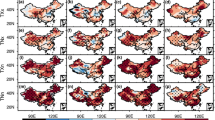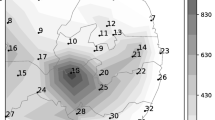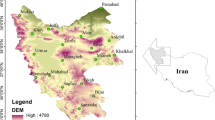Abstract
As an intrinsic feature of daily surface air temperature (SAT) variability found in station measurements, temporal asymmetry (TA) can be taken as an evaluation metric to access the quality of SAT re-analysis product. In this study, TA calculated from four SAT variables, i.e., daily mean SAT (Tmean), daily maximum SAT (Tmax), daily minimum SAT (Tmin) and diurnal temperature range (TDTR = Tmax − Tmin), is applied to evaluate synoptic-scale performance of four reanalysis products (NCEP-2, JRA-55, ERA-I, and ERA-5) over China. The results show that four re-analyses overall overestimate the TA of daily Tmax and Tmin variability over China, but with a comparatively consistent estimated TA for Tmean. Moreover, the TA of Tmean variability for these four re-analyses shares high spatial consistency with those from the observation. However, four re-analyses own the similar region-dependent spatial patterns of overestimated TA for Tmax and Tmin variability, especially for Tmax. Since high TA is an indicator for strong nonlinear feature, only Tmean reanalysis is the most suitable to explore synoptic-scale extreme events, such as heat waves and cold waves, which are highly related to the strong nonlinear processes.








Similar content being viewed by others
Data availability
All observed records for these four temperature variables were downloaded from the China meteorological data sharing service system (http://cdc.cma.gov.cn). Reanalysis NCEP-2 products were acquired from the National Oceanic and Atmospheric Administration (NOAA) and its website at http://www.esrl.noaa.gov/psd. JRA-55 is produced by the Japan Meteorological Agency (JMA) (https://climatedataguide.ucar.edu/climate-data/jra-55). From the ECMWF’s website: https://www.ecmwf.int/en/forecasts/datasets/browse-reanalysis-datasets, both ERA-I, and ERA-5 are downloaded.
References
Alfred M, Powell Jr, Xu JJ (2011) A new assessment of the mid-1970s abrupt atmospheric temperature change in the NCEP/NCAR reanalysis and associated solar forcing implications. Theor Appl Climatol 104:443–458
Alghamdi AS (2020) Evaluation of four reanalysis datasets against radiosonde over Southwest Asia. Atmosphere 11:402
Ashkenazy Y, Tziperman E (2004) Are the 41 kyr glacial oscillations a linear response to Milankovitch forcing? Quat Sci Rev 23:1879–1890
Ashkenazy Y, Feliks Y, Gildor H, Tziperman E (2008) Asymmetry of daily temperature records. J Atmos Sci 65:3327
Ashkenazy Y, Fredj E et al (2016) Current temporal asymmetry and the role of tides: Nan-Wan Bay vs. the Gulf of Elat. Ocean Sci 12:733
Ayataka E et al (2011) The Japanese 55-year reanalysis “JRA-55”: an interim report. SOLA 7:149–152
Bartos I, Jánosi IM (2005) Atmospheric response function over land: strong asymmetries in daily temperature fluctuations. Geophys Res Lett 32:L23820
Bengtsson L, Shukla J (1988) Integration of space and in situ observations to study global climate change. Bull Am Meteor Soc 69:1130–1143
Bisgaard S, Kulahci M (2011) Time series analysis and forecasting by example. Wiley, New York
Chen GX, Iwasaki T (2014) Evaluation of the warm-season diurnal variability over East Asia in recent reanalyses JRA-55, ERA-interim, NCEP CFSR, and NASA MERRA. J Clim 27:5517–5537
Chen B, Liu Z (2016) Global water vapor variability and trend from the latest 36 year (1979 to 2014) data of ECMWF and NCEP reanalyses, radiosonde, GPS, and microwave satellite. J Geophys Res 121:11442–11462
Cornes RC, Jones PD (2013) How well does the ERA-interim reanalysis replicate trends in extremes of surface temperature across Europe? J Geophys Res 118:10262–10276
Dee DP, Coauthors (2011) The ERA-interim reanalysis: configuration and performance of the data assimilation system. Quart J Roy Meteor Soc 137:553–597
Diaconescu EP, Mailhot A, Brown R, Chaumont D (2018) Evaluation of CORDEX-Arctic daily precipitation and temperature based climate indices over Canadian Arctic land areas. Clim Dyn 50(5–6):2061–2085
Flocas HA, Tolika K, Anagnostopoulou C, Patrikas I, Maheras P, Vafiadis M (2005) Evaluation of maximum and minimum temperature of NCEP-NCAR reanalysis data over Greece. Theor Appl Climatol 80:49–65
Gyure B, Bartos I, Janosi IM (2007) Nonlinear statistics of daily temperature fluctuations reproduced in a laboratory experiment. Phys Rev E 76:037301
He WP, Zhao SS (2018) Assessment of the quality of NCEP-2 and CFSR reanalysis daily temperature in China based on long-range correlation. Clim Dyn 50:493
Heinrich H (2004) Origin and consequences of cyclic ice rafting in the Northeast Atlantic Ocean during the past 130,000 years. Quat Res 29:142–152
Hersbach H, Bell B, Berrisford P et al (2020) The ERA5 global reanalysis. Quart J Roy Meteor Soc 146:1999–2049
Huang Y, Fu ZT (2019) Enhanced time series predictability with well-defined structures. Theor Appl Climatol 138:373–385
Huang Y et al (2020) Systematic identification of causal relations in high-dimensional chaotic systems: application to stratosphere-troposphere coupling. Clim Dyn 55:2469–2481
Kanamitsu M et al (2002) NCEP-DOE AMIP-II reanalysis (R-2). Bull Am Meteorol Soc 83:1631
King T (1996) Quantifying nonlinearity and geometry in time series of climate. Quat Sci Rev 15:247–266
Kobayashi S, Ota Y, Harada Y, Ebita A, Moriya M, Onoda H, Onogi K, Kamahori H, Kobayashi C, Endo H, Miyaoka K, Takahashi K (2015) The JRA-55 reanalysis: general specifications and basic characteristics. J Metorol Soc Jpn 93:5–48
Koscielny-Bunde E, Bunde A, Havlin S, Roman HE (1998) Indication of a universal persistence law governing atmospheric variability. Phys Rev Lett 81:729
Lacasa L, Nunez A, Roldan E, Parrondo JMR, Luque B (2012) Time series irreversibility: a visibility graph approach. Eur Phys J B 85:217
Li RC, Huang Y, Xie FH, Fu ZT (2021) Discrepancies in surface temperature between reanalysis and station observations over China and their implications. Atmos Oceanic Sci Lett 14:100008
Lisiecki LE, Raymo ME (2005) A Pliocene-Pleistocene stack of 57 globally distributed benthic delta O-18 records. Paleoceanography 20:PA1003
Livina V, Ashkenazy Y, Kizner Z, Strygin V, Bunde A, Havlin S (2003) A stochastic model of river discharge fluctuations. Phys A 330:283–290
Ma L, Zhang T, Li Q, Frauenfeld OW, Qin D (2008) Evaluation of ERA-40, NCEP-1, and NCEP-2 reanalysis air temperatures with ground-based measurements in China. J Geophys Res 113:D15115
Mao J, Shi X, Ma L, Kaiser DP, Li Q, Thornton PE (2010) Assessment of reanalysis daily extreme temperatures with China’s homogenized historical dataset during 1979-2001 using probability density functions. J Clim 23:6605–6623
Marques CAF, Rocha A, Corte-Real J (2010) Comparative energetics of ERA-40, JRA-25 and NCEPR2 reanalysis, in the wave number domain. Dyn Atmos Oceans 50:375–399
Mooney PA, Mulligan FJ, Fealy R (2011) Comparison of ERA-40, ERA-interim and NCEP/NCAR reanalysis data with observed surface air temperature over Ireland. Int J Climatol 31:545–557
Pendergrass AG, Knutti R (2018) The uneven nature of daily precipitation and its change. Geophys Res Lett 45(21):11980–11988
Pinheiro HR et al (2020) An intercomparison of subtropical cut-off lows in the southern hemisphere using recent reanalyses: ERA-interim, NCEP-CFRS, MERRA-2, JRA-55, and JRA-25. Clim Dyn 54:777–792
Piskala V, Huth R (2020) Asymmetry of day-to-day temperature changes and its causes. Theor Appl Climatol 140(4):683–690
Pitman AJ, Perkins SE (2009) Global and regional comparison of daily 2-m and 1000-hPa maximum and minimum temperatures in three global reanalysis. J Clim 22:4667–4681
Quan H, Chai WM, Fu ZT (2021) Asymmetry of daily mean temperature series over China and its frontal mechanism. Int J Climatol 1-13. https://doi.org/10.1002/joc.7338
Radu CR, Rozum I, Schepers D, Simmons A, Soci C, Dee D, Thépaut JN (2018) ERA5 hourly data on single levels from 1979 to present. Copernicus Climate Change Service (C3S) Climate Data Store (CDS). (Accessed on < 26-02-2021 >), https://doi.org/10.24381/cds.adbb2d47
Raghavendra A, Dai AG, Milrad SM, Cloutier-Bisbee SR (2018) Floridian heatwaves and extreme precipitation-future climate projections. Clim Dyn 52:495–508
Roldan E, Parrondo JMR (2010) Estimating dissipation from single stationary trajectories. Phys Rev Lett 105:150607
Rusticucci MM, Kousky E (2002) A comparative study of maximum and minimum temperatures over Argentina: NCEP-NCAR reanalysis versus station data. J Clim 15:2089–2101
Schreiber T, Schmitz A (2000) Surrogate time series Phys D 142:346–382
Taguchi M (2017) Comparison of large-scale dynamical variability in the extratropical stratosphere among the JRA-55 family data sets: impacts of assimilation of observational data in JRA-55 reanalysis data. Atmos Chem Phys 17:11193–11207
Taylor KE (2001) Summarizing multiple aspects of model performance in a single diagram. J Geophys Res 106:7183–7192
Trenberth KE, Olson JG (1988) An evaluation and intercomparison of global analyses from national meteorological center and the European Centre for Medium Range Weather Forecast. Bull Am Meteor Soc 69:1047–1057
Wang S, Zhang M, Sum M, Wang B, Huang X, Wang Q, Feng F (2015) Comparison of surface air temperature derived from NCEP/DOE R2, ERA-interim, and observations in the arid northwestern China: a consideration of altitude errors. Theor Appl Climatol 119:99–111
Xie FH, Fu ZT, Piao L, Mao JY (2016) Time irreversibility of mean temperature anomaly variations over China. Theor Appl Climatol 123:161
Xie FH, Nian D, Fu ZT (2019) Differential temporal asymmetry among different temperature variables’ daily fluctuations. Clim Dyn 53:585–600
Yang LC, Franzke CL, Fu ZT (2020) Power-law behaviour of hourly precipitation intensity and dry spell duration over the United States. Int J Climatol 40:2429–2444
Ye ZQ, Hsieh WW (2008) Enhancing predictability by increasing nonlinearity in ENSO and Lorenz systems. Nonlin Processes Geophys 15:793–801
You Q, Kang S, Aguilar E, Pepin N, Flugel W, Yan Y, Xu Y, Zhang Y, Huang J (2011) Changes in daily climate extremes in China and their connection to the large scale atmospheric circulation during 1961-2003. Clim Dyn 36:2399–2417
You Q, Fraedrich K, Min J, Kang S, Zhu X, Ren G, Meng X (2013) Can temperature extremes in China be calculated from reanalysis? Glob Planet Change 111:268–279
Zhang BE, Xie FH, Fu ZH, Fu ZT (2019) Comparative study of multiple measures on temporal irreversibility of daily air temperature anomaly variations over China. Phys A 523:1387–1399
Zhao SS, He WP, Jiang YD (2018) Evaluation of NCEP-2 and CFSR reanalysis seasonal temperature data in China using detrended fluctuation analysis. Int J Climatol 38:252–263
Zhu J, Huang D, Yan P, Huang Y, Kuang X (2017) Can reanalysis datasets describe the persistent temperature and precipitation extremes over China? Theor Appl Climatol 130:655–671
Code availability
Not applicable.
Funding
This research was supported by the National Natural Science Foundation of China through Grants (Nos. 41475048 and 41975059).
Author information
Authors and Affiliations
Contributions
Study design: Zuntao Fu, Wenmi Chai; data collection: Wenmi Chai; statistical analysis: Wenmi Chai; result interpretation: Zuntao Fu, Wenmi Chai; manuscript preparation, and review: Wenmi Chai, Yu Huang, Lichao Yang, Heng Quan, and Zuntao Fu.
Corresponding author
Ethics declarations
Ethics approval
We confirm that this article is an original research and has not been published or presented previously in any journal or conference in any language (in whole or in part).
Consent to participate and consent for publication
We have consent to participate and publish.
Conflict of interest
The authors declare no competing interests.
Additional information
Publisher’s note
Springer Nature remains neutral with regard to jurisdictional claims in published maps and institutional affiliations.
Key points
• Four re-analyses all overestimate the temporal asymmetry of daily maximum and minimum temperature variability over China.
• For overestimated temporal asymmetry, four re-analyses own the similar region-dependent spatial patterns.
• Daily mean air temperature variability of re-analyses is the most suitable for extreme event study.
Rights and permissions
About this article
Cite this article
Chai, W., Huang, Y., Yang, L. et al. Evaluation of re-analyses over China based on the temporal asymmetry of daily temperature variability. Theor Appl Climatol 147, 753–765 (2022). https://doi.org/10.1007/s00704-021-03839-y
Received:
Accepted:
Published:
Issue Date:
DOI: https://doi.org/10.1007/s00704-021-03839-y




